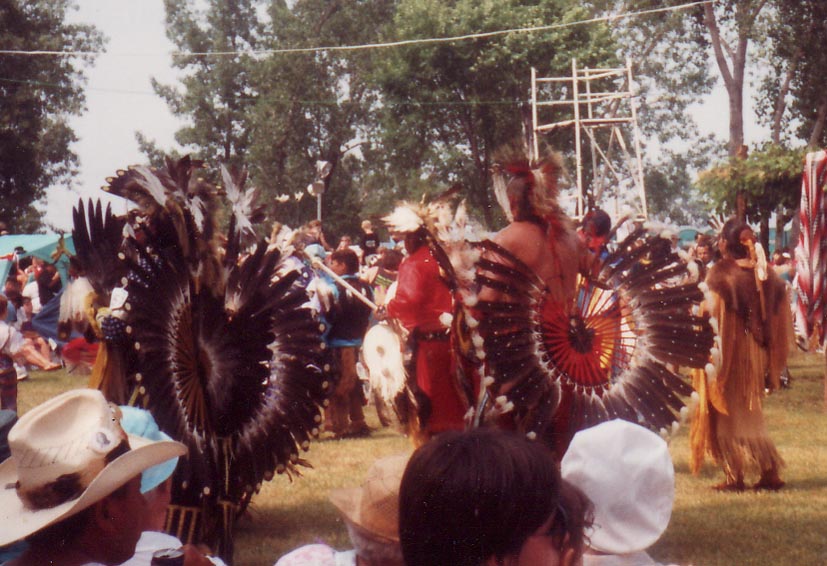
Pow Wow

The Fourth Homecoming Pow Wow at Kahnawake, Quebec in 1994
Kahnawake was the scene of the "Oka" crisis of 1990
.
|
Pow Wow Idol Vote for the Chippewa Travellers at, http://powwowidol.powwows.com/ Voting closes 18th April 2010 |
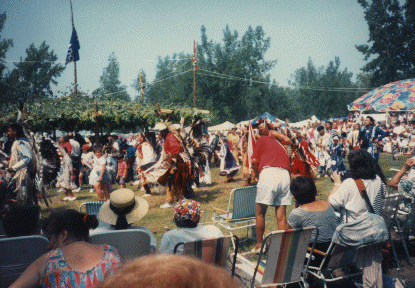
The
pow wow is an activity unlike anything in the culture of non-natives.
The
pow wow is a spiritual gathering of nations,
while at
the same time
it serves
to distinguish between
the social
and cultural differences that set natives apart from other societies.
Indeed, the pow wow is the expression of a way of life for native communities
across Canada and the United States.
And while the pow wow is
colour in motion to most
non-natives, to North
American Indians the pow wow serves a far greater purpose.
Despite
the ever-changing face of the nation on both the
social and political
fronts, pow wow tradition
is one constant that remains throughout First Nations communities.
As
well, the pow wow serves to bond tribes and bands of different linguistic
geographical locations, building a bridge between it's paricipants.
All Indians, whether they are of Ojibway, Iroquois or
Sioux descent, are
welcomed to take part in the intertribal
festivities.
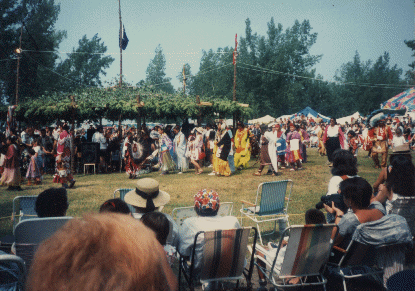
Women's Traditional Dance
From
early spring to late fall, year
after year, natives from
across North
America travel great distances to
gather and
to celebrate their heritage through singing and dancing.
It is the expression of
harmony among First nations and a way of life
that has not been forgotten. The history of the pow wow is a long one.
One must
go back to the arrival
of French
explorer Jacques Cartier, in 1534,
to the "new
world" for the first
recorded account of native dancing.
carter recorded that up0n his arrival at
the mouth of the St Laurence river,
he was greeted by seven
canoes filled with Indian
warriors dancing while the women, knee deep in water,
danced along the shoreline. Cartier
also noticed that he had landed among the Algonquin Indians.
Further
up the river, he was again
greeted in a likewise manner, upom his
arrival in the Iroquois village of Hochelaga.
It was observed and recorded by Cartier that dancing was universal
to the native communities,
as well as vital to their
ceremonial practises.
The
term pow wow is a European term that has since been borrowed back by natives.
"Pau
wau", which means medicine man or conjuror, was misconstrued by European
settlers who witnessed the healing practises of the village shaman as he was also known as.
The
frequent use of the word was taken to mean "the gathering
of natives" that surrounded
the medicine
man during healing
practices, rather
than the man himself. Since
the Nineteenth century,
"pow wow" has largely
been associated with any meeting, religious or
social event
involving natives.
The pow
wow therefore, can be said to be a gathering of First Nations.
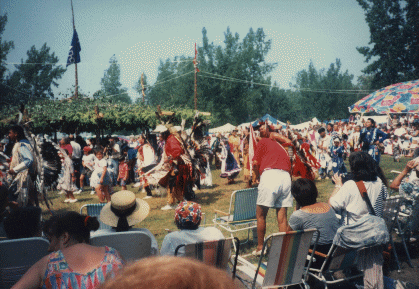
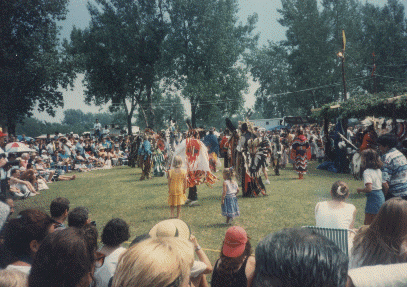
The
historical origins
of the pow wow point
to the Plains Indians of
The United States. Other accounts state that
the Algonquin Indians of New England played a significant role in the
development of the modern day pow wow as it is commonly regarded. Probably
the most significant renderings of native life in the early
days of European exploration can be realised
through the artistic works
of George Catlin.
Catlin
spent eight years amongst the Sioux Indians of the Plains in the
early 1830's, painting and writing about their
way of life.
He is regarded as the best
known of the American artists who depicted Indian life. His writings are also valuable sources of information.
Natives
lived an oral tradition and
taught the ceremonies
and dances to
future generations by word of
mouth. Therefore, the
writings and paintings of settlers, in particular George Catlin, are primary
sources for historical analysis, as
far as the early pow wow traditions are concerned.
Today,
not unlike
the days of initial contact with the
first
European
settlers, the pow wow continues to
bring First Nations together;
harmoniously and with great pride and dignity.
Reproduced
with the kind permission of The Mississuagas of the New Credit
First Nation
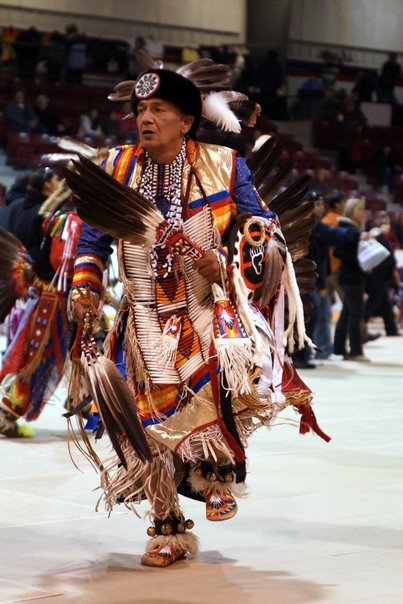
Photograph taken at Hamilton Pow Wow by James Simcoe
Russell Noganosh - Native Canadian Artist, Dancer and Singer
There is a great flute player from the USA called Joseph Firecrow. Visit his site at, http://www.josephfirecrow.com/
If you don't see a menu hit the above link to reload this site.